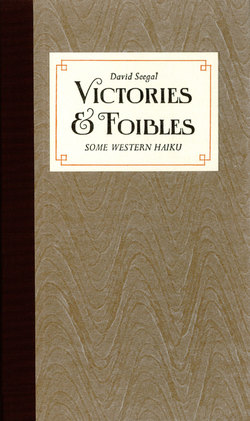Читать книгу Victories & Foibles - David Seegal - Страница 8
На сайте Литреса книга снята с продажи.
ОглавлениеPREFACE
THE FOLLOWING HAIKU VERSES, WRITTEN IN AN American style, are departures from the exacting nature of this Japanese poem. By relaxing the restraints upon subject and style, the American poet gains the. opportunity to experiment with and to possibly enhance the classic Eastern examples. Although Japanese savants differ about the precise poetics of haiku, they agree that these short poems, highly successful since the thirteenth century, should be composed of three lines, the first and last bearing five syllables and the second bearing seven syllables. Henderson and Blyth, among other eminent critics, expect the verses to record immediate moments of high emotional intensity in a variety of moods. The effectiveness of the poems depends largely upon the readers' or listeners' capacity to emotionally fill in undisclosed parts of the piece. It has been said that haiku-reading is indeed an art-the poem must be read and reread so that the overtones will not be lost. The ideal poetical relationship for haiku-reading arises when both the poet and the reader possess and express high degrees of associative ideation. Thus references to nature and season may be offered in countless ways to convey the poet's thoughts.
The continued popularity of orthodox haiku is evident. Hundreds of thousands of these verses are published annually in Japan alone. The classic form must perforce serve both the needs of the Japanese poet and the hunger of the readers for the verses. The Westerner, often unfamiliar with haiku, may be surprised by the popularity of an Eastern verse form that was born so long ago and that is bound by so many stylistic restrictions. In fact, in addition to adhering to stylistic rules, the great haiku poets limited their subjects. Basho, Issa, and Buson shunned sentimentality and avoided subjects like untruth, hate, ugliness, war, poisonous plants, ferocious animals, floods, and pestilence. The American haiku poet who mutely accepts these restrictions, however, forfeits many areas of literary exploration and innovation.
Although I used the traditional five -seven-five syllabic haiku structure in the poems in this volume and tried constantly to work with haiku modes of suggestion, mood, and overtones, I did not limit the subject matter. It is my belief that the never-ending conflict man has with himself, the dissonance among men, and the protean character of nature offer an infinite variety of scenes intriguing to the poet. These conflicts reflect the history of the human race, and their representation should not be denied the haiku poet who wishes to use a suitable lyric style to comment on the victories and foibles of man.
A word should be added about the use of titles for the individual poems. Classical Japanese haiku are not titled. However, I find that an appropriate title helps to identify a verse, assists in developing the required mood, and offers a challenge to the poet intrigued by the brevity of the instrument before him.
DAVID SEEGAL, M.D.
New York
